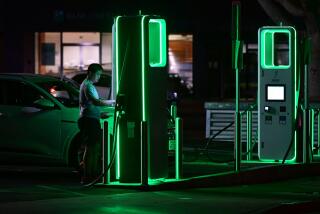U.S. auto sales zoom in the wake of Superstorm Sandy
With the presidential election and Superstorm Sandy behind them, car shoppers headed for dealer lots last month in the biggest numbers since early 2008.
Multiple brands, including Honda, Nissan, Hyundai and BMW, had their best Novembers ever last month. The import nameplates generally reported stronger gains than the domestic brands, helped by new products such as the new-generation Honda Accord and a new Nissan Pathfinder sport utility vehicle.
Automakers sold more than 1.1 million vehicles last month, a 15% gain over November 2011. Bolstered by shoppers replacing some of the 250,000 vehicles estimated to have been destroyed by Sandy, that translated into a seasonally adjusted annual rate of about 15.5 million, the highest since January 2008, according to industry research firm Autodata Corp.
Consumers leaned toward fuel-efficient cars and small SUVs. With gas prices around $3.50 a gallon in much of the nation, and even higher in car-crazy California, sales of hybrid vehicles also appear to be taking off.
Led by its hot-selling Prius line of hybrids, Toyota Motor Corp. posted November hybrid vehicle sales of 24,682 in the U.S., a 29% increase over the same month last year.
But for the first time since it started selling hybrids in the U.S. in 2000, Toyota has serious competition in the hybrid market.
Ford Motor Co. said it sold nearly 5,000 of its new C-Max hybrid in November, up about 50% from the car’s first full month of sales in October. Combined with its other offerings, the automaker sold about 6,500 hybrids in November, its best month ever for those vehicles, which use both gas and electric motors to increase fuel efficiency.
Ford has sold 9,000 of the C-Max models since they first went on sale a little more than two months ago. That amounts to about a quarter of the hybrid volume the automaker sold in all of 2011 and underscores how important the vehicle is to Ford’s hybrid strategy. If C-Max sales keep on pace, the automaker will easily double its hybrid sales in the current model year.
Certainly hybrids are starting to catch on with consumers. Sales of hybrids by Toyota and Ford and General Motors Co.’s Chevrolet Volt — technically a plug-in hybrid that runs on gasoline once its electric battery charge runs out — were nearly 35,000 last month, up about 40% from November 2011.
Sales of hybrids and plug-in electric cars are expected to top 500,000 in the U.S. for the first time both in this calendar year and in the 2013 model year, said Alan Baum of the Baum & Associates research firm. That would be about 3.5% of the U.S. auto market.
One buyer is Kate Ochsman, a West Hollywood actress who recently purchased a white C-Max. Ochsman said she now spends about $50 to fill up the Ford every two weeks instead of the $80 a week she spent to gas up a BMW X5 SUV with a V-8 engine.
“I really like it,” Ochsman said. The car is “great getting around anywhere in L.A., and it is almost eerily quiet. It has a lot of bells and whistles, but it does drive like a hybrid. It doesn’t have the power my BMW had.”
About a quarter of Ford’s C-Max sales are in California, a market dominated by Toyota, especially in the hybrid market.
“That’s strategically important to Ford, because California is a market where our share has been traditionally lower,” said C.J. O’Donnell, the automaker’s electrified-vehicle marketing manager. “The No. 1 trade-in is a Prius, followed by some of the Honda products.”
In its marketing efforts, Ford is pitching the C-Max as a head-to-head competitor with the Prius V, a small station wagon. Toyota sold about 2,700 of the Prius V last month, about 2,300 fewer than Ford’s C-Max sales.
Toyota has responded by pointing out that the C-Max is closer in size to the smaller Prius hatchback model, yet gets about 6% poorer fuel economy and has a base price about 15% higher.
“The Prius V has more versatility and cargo space than C-Max,” said Bill Fay, general manager of the automaker’s Toyota division in the U.S.
Overall, Toyota’s November sales rose to 161,695 vehicles, up 17.2% from the same month last year. Ford sales rose 6.4% to 177,092 vehicles.
General Motors Co. reported its highest November U.S. sales volume since 2007, with deliveries up 3.4% from a year earlier to 186,505 vehicles. Chrysler Group sales rose 14.4% to 122,565 units, its best November since 2007.
Volkswagen Group sales — including Audi — rose 28.2%, to 49,062 vehicles. It was the VW brand’s best November since 1973.
American Honda Motor Co. sales jumped 38.9% in November, reaching 116,580 vehicles, an all-time record for the month.
“We are now surpassing sales records set pre-recession, a true sign that our business has recovered,” said John Mendel, executive vice president of sales at American Honda.
Nissan North America reported record November U.S. sales of 96,197 vehicles, up 12.9%.
Hyundai Motor America also posted a record November, with U.S. sales up 7.8% to 53,487 vehicles.
And BMW reported its best U.S. sales month ever, with November sales of 31,213, an increase of 45% from a year earlier.
Whether the industry can continue to sell at this pace depends largely on the federal budget negotiations underway between Congress and the Obama administration, executives at several automakers said Monday.
“Exactly how much growth we can expect next year will depend in part on how Congress and the president resolve the ‘fiscal cliff’ issue. We are certainly not going to prescribe policy fixes,” said Kurt McNeil, GM’s vice president of U.S. sales operations. “But I will say that markets and consumers hate the uncertainty.”
More to Read
Inside the business of entertainment
The Wide Shot brings you news, analysis and insights on everything from streaming wars to production — and what it all means for the future.
You may occasionally receive promotional content from the Los Angeles Times.











